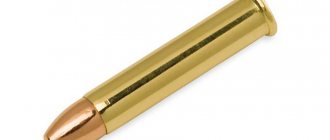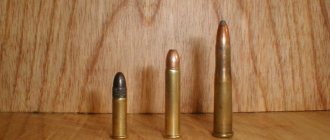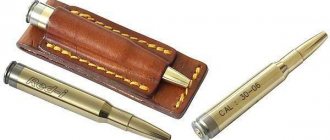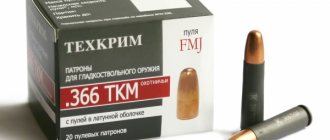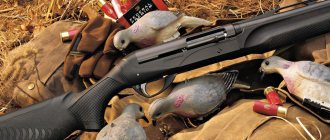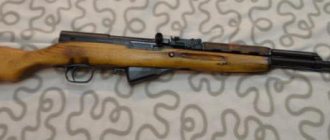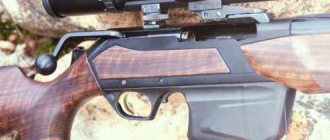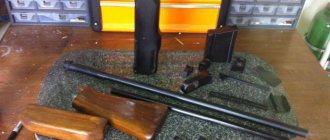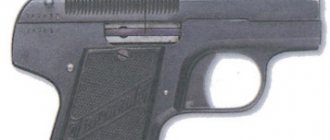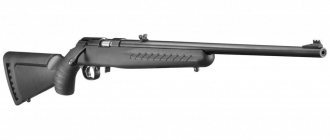Creation
The American company developed this cartridge for hunting purposes back in 1963. The British analogue of the H&H company was taken as the basis. This ammunition was already the fourth creation of a characteristic shape: with a slight belt-like thickening of the cartridge case in the bottom area.
In general, the very idea of creating powerful caliber hunting cartridges for targeted shooting was developed thanks to the appearance of ammunition for safari in Africa. The .300 Win caliber occupied a special place in the evolutionary chain. Mag. along with the .223 Remington, 30-06 Springfield and .308 Winchester.
History of cartridges[edit]
Prior to the development of the .300 Winchester Magnum, there were several cartridges that provided what could best be described as great levels of energy. The history of the .30 caliber (7.62 mm) magnum dates back to the .30 Newton in 1913 and the .300 H&H Magnum in 1925. The .300 H&H Magnum was too long for standard-length Mauser and Springfield rifles and required specialized rifles with Magnum action.
Beginning with the .270 Weatherby Magnum in 1943, Roy Weatherby introduced a line of cartridges that, although based on the H&H Magnum case, were shortened to fit the standard length (2.5 inches [63.50 mm]). Weatherby cartridges involved blowing (reducing the taper) of Magnum H&H cases, bringing them down to the proper caliber, and shortening them to fit standard rifle actions of the era. The .300 Wetherby Magnum was introduced in 1944.
Weatherby's standard length Magnum case was soon spotted. In 1958, Winchester introduced three cartridges—the .264 Winchester Magnum, .338 Winchester Magnum, and .458 Winchester Magnum—all based on the shortened and blown .375 H&H Magnum case. The omission of the popular .30 caliber from this line was not lost. Wildcatters soon released the .30-338 Winchester and Norma Projektilfabrik, who were by then making ammunition for Weatherby, took the standard length from Weatherby's base brass, shortened it to .30 caliber (7.62mm) and called it the .308 Norma Magnum. [6]
The .300 Winchester Magnum was introduced in 1963 by Winchester for use in the Model 70 rifle. The introduction of the .300 Winchester Magnum rifle was not unexpected; rather, its introduction was disappointing[ edit
] . Winchester developed the .300 Winchester Magnum by taking the .338 Winchester Magnum, which was introduced in 1958, and moving the shoulder forward 4.0 mm (0.156 in) and lengthening it 3.0 mm (0.120 in). This resulted in the cartridge neck being shorter than the bullet diameter. There has been some speculation that if the cartridge had been released earlier, its dimensions would have been the same as the .30-338 Winchester Wildcat cartridge. Since its introduction, the cartridge has remained extremely popular.[7]
The high availability of .300 Winchester Magnum in popular rifles such as the Winchester Model 70 and Remington Model 700 has made the cartridge popular with shooters. Although the .300 H&H Magnum, .30-338 Winchester Magnum, and .308 Norma Magnum had advantages over the .300 Winchester Magnum, these cartridges soon became obsolete. Only the .300 Winchester Magnum has survived as a readily available cartridge. Other cartridges, although available, are more expensive. [ citation needed
]
Market battles
The Western world of the 60-70s can be characterized as an arms race among medium calibers. At first, the already established “Magnum” cartridges managed to maintain a stable leading position in the market, until they were supplanted by two Magnum class calibers developed by Roy Weatherby: 338-378 Weatherby Magnum and 224 Weatherby Varmintmaster.
The race continues with the already mentioned .300 Winchester Magnum caliber for sale. This is where the very ammunition that has gained worldwide popularity appears.
Five years later, Remington Arms Company will try to surpass it with the .350 Remington Magnum caliber cartridge, due to whose commercial activities interest in Magnum-type “belt cartridges” has slightly decreased.
But this increased again with the advent of the A-Square company in the 70s, which introduced the world to new bullets and calibers: 500, 416, 495 and 460. The company remained a leader in the international market for three decades. Their ammunition was distinguished by a specific shape: a bullet with a blunt (almost rounded) end and a large mass - 32 grams. Intended for very large African game. The hunting cartridge was called “Triad”.
Powerful .300 Norma Magnum cartridge
The .300 Norma Magnum is an effective medium-sized cartridge designed for medium to long range shooting. It has outstanding accuracy potential. This ammunition is based on the .338 Norma Magnum cartridge, developed by Norma as an alternative to the .338 Lapua Magnum cartridge.
Following the success of the .338 Lapua Magnum cartridge as a long-range ammunition, Norma management decided to develop its own cartridge with similar characteristics. It was the .338 Norma Magnum cartridge, launched into production in 2009. The .300 Norma Magnum is essentially a .338 Norma Magnum chambered in .308”. According to the designers, the cartridge's characteristics were to surpass the competitor of the Lapua company (.338 Lapua Magnum), which at that time, as a rule, was equipped with bullets weighing 250 grains. The new .338 Norma Magnum ammunition featured a Sierra Matchking bullet weighing 300 grains.
The .338 Norma Magnum cartridge has a case length of 63.3 mm, which is slightly shorter than the .338 Lapua Magnum cartridge (69.2 mm) and almost the same length as the .30–06 Springfield cartridge. Compared to the .338 Lapua Magnum, the case volume of the .338 Norma Magnum cartridge is 6.5% smaller. The overall length of the .338 Norma Magnum and .338 Lapua Magnum cartridges is the same and is 93.5 mm. The prototype of the .338 Norma Magnum cartridge is a non-standardized experimental cartridge. US sports shooter Jimmy Sloan developed it together with Dave Kiff, owner of Pacific Tool and Gauge, a company that produces chambering reamers and calibers. This cartridge was to be 91.44mm long, suitable for chambering Magnum class rifles chambered in .375 Holland & Holland. The developers loaded the cartridge with a Sierra HPBT Matchking bullet (Hollow Point Boat Tail - an expansive bullet with a conical tail. - Translator's note). The Norma company standardized the ammunition, which on May 26, 2010 was included in the official cartridge lists of the Permanent International Commission for the Testing of Handguns. In accordance with them, the length of the cartridge is 93.5 mm. Due to changes in case shape, such as rake angle and muzzle length, the lighter powder charge allowed the 300-grain bullet to achieve similar velocities to the .338 Lapua Magnum. Additionally, when shooting the .338 Norma Magnum cartridge, there is less recoil and less muzzle flash. And this is not counting the almost doubling of barrel survivability.
From left to right. Cartridges loaded with the 230-grain Berger Hybrid bullet, the 200-grain Hornady ELD-X bullet, and the 208-grain Hornady ELD-Match bullet.
| Bullet | Series of 10 shots, distance 100 m | Series of 5 shots, distance 300 m |
| Norma Berger Hybrid 230 grain | 17 mm | 40 mm |
| Hornady ELD Match 208 grain handload* | 23 mm | 41 mm |
| Hornady ELD-X 200 grain hand load** | 28 mm | 44 mm |
| Nosler Accubond Long Range 210 grain handload*** | 30 mm | 61 mm |
| Sierra HPBT Matchking 240 grain handload**** | 24 mm | 49 mm |
| * Sleeve from Norma; capsule RWS 5333; Hodgdon H1000 powder, powder charge weight 87 grains; cartridge length 93 mm. ** Sleeve from Norma; capsule RWS 5333; Norma 217 powder, powder charge weight 91 grains; cartridge length 93.4 mm. *** Sleeve from Norma; capsule RWS 5333; Vihtavuori N570 gunpowder, powder charge weight 92 grains; cartridge length 93.2 mm. **** Sleeve from Norma; capsule RWS 5333; Hodgdon Retumbo powder, powder charge weight 88 grains; cartridge length 93.5 mm. The use of the data given in the table is carried out at personal responsibility. The author and publisher do not bear any responsibility. |
The .300 Norma Magnum cartridge was based on the .338 Norma Magnum ammunition. The latter was simply re-compressed to a smaller caliber of 0.308”. The .300 Norma Magnum cartridge appeared on the market in 2012. Both cartridges are loaded into the same magazines and also have the same mirror gap. The generally accepted rifling pitch for .300 Norma Magnum barrels designed to fire bullets weighing 200 grains or more is 1:9” (229 mm). Berger Hybrid weighing 230 and 215 grains can be considered ideal bullets. The Norma company equips its own cartridges with Berger bullets weighing 230 grains. With a base diameter of 14.93 mm (for the .416 Rigby cartridge - 14.99 mm), the wafer sleeve has a length of 63.3 mm. Above the annular groove, the diameter of the sleeve is 14.87 mm. Before the slope, the sleeve narrows somewhat - at the slope its diameter is 14.29 mm. The slope angle is 41°. According to initial calculations, the total length of the ammunition should have been 91.44 mm, which corresponds to the standard chamber of a Magnum class weapon. However, then this figure was changed to 93.5 mm, which is equal to the length of cartridges equipped with heavy elongated match bullets. The maximum pressure of powder gases is 4400 bar.
Norma's 230-grain Berger bullet has a muzzle velocity of 910 m/s and is nearly ideal for precision and long-range shooting. Unlike the .308 Norma Magnum, .300 Winchester Magnum, .300 Weatherby Magnum, .30-378 Weatherby Magnum, .300 Remington Ultra Magnum and .30 Nosler ammunition, the .300 Norma Magnum was designed from the outset for use with heavy bullets, the weight of which significantly exceeds 200 grains. Of course, when shooting long range with the .300 Norma Magnum, its massive 230-grain long bullets outperform the competition. For these bullets, barrels with a rifling pitch of 1:9” (229 mm) are best suited. Thus, the .300 Norma Magnum cartridge is designed for shooting at long ranges, as well as at distances from 600 to 1000 m. After a distance of 1500 m, its effectiveness is lost. The bullet's supersonic flight speed is maintained up to a distance of 1540 m.
| Bullet | Bullet flight speed (m/s) | |||||||||||
| V0 | V100 | V200 | V300 | V400 | V500 | V600 | V700 | V800 | V900 | V1000 | ||
| Norma Berger Hybrid, 230 grains | 910 | 865 | 822 | 780 | 739 | 699 | 661 | 624 | 588 | 553 | 520 | |
| Bullet | Bullet energy (J) | |||||||||||
| E0 | E100 | E200 | E300 | E400 | E500 | E600 | E700 | E800 | E900 | E1000 | ||
| Norma Berger Hybrid, 230 grains | 6169 | 5576 | 5056 | 4529 | 4068 | 3645 | 3256 | 2900 | 2576 | 2282 | 2017 | |
| Bullet | Excess of the bullet flight path above the aiming line (cm) at a shooting distance of 195 m | |||||||||||
| 0 | 100 | 195 | 200 | 300 | 400 | 500 | 600 | 700 | 800 | 900 | 1000 | |
| Norma Berger Hybrid, 230 grains | -5 | +3,8 | 0,00 | -0,53 | -19,4 | -54,4 | -107,5 | -180,6 | -276,1 | -397,0 | -546,2 | -725,6 |
From left to right.
Comparison: .300 Norma Mag., .300 WSM, .300 Win. Mag., .300 Wby. Mag., .300 RUM., .30-378 Wby. Mag. And the dispersion diameter obtained when shooting from a Blaser R8 carbine from a distance of 100 m, the holes overlapped each other. Due to the fact that Norma only offers one load option, the .300 Norma Magnum can be considered a typical reloading cartridge. The cases have primers designed for Magnum class cartridges. Progressive Magnum grade powders such as Norma 217, Hodgdon H4831, IMR 7828, Alliant Reloder 25, and Vihtavuori N165 and N170 are ideal for powder charges. It is not recommended to load cartridges with bullets weighing less than 200 grains. However, shooting accuracy can also be checked with bullets weighing 180 grains. For long-range shooting, match bullets weighing over 200 grains are ideal, such as the Sierra HPBT Matchking (210, 220 and 240 grains) or the Berger Hybrid Target (230 grains), Berger Hybrid Target (215 grains), and the Berger VLD Target ( 210 grains). The highest accuracy has been achieved using the new Hornady ELD Match bullets.
When shooting from a Blaser R8 repeating carbine with a total length of 1135 mm and a weight of 3860 g, equipped with a Swarovski X5i 3.5-18x50P optical sight, the recoil force was quite noticeable. When firing in series of five shots from a distance of 100 m, the dispersion diameters ranged from 11 to 13 mm, and when firing in series of ten shots from the same distance - 17 and 18 mm. When firing in series of five shots at a distance of 300 m, the dispersion diameters were 40, 41, 44 and 49 mm. These exceptionally good results not only demonstrate the capabilities of the Blaser R8 carbine, but also, above all, highlight the high accuracy of the .300 Norma Magnum cartridge.
The 220 grain Berger VLD Hunting bullet is best suited for hunting. Sierra Gameking (200 grains) or Nosler Accubond Long Range (210 grains) bullets will also be no worse. The 200 grain Barnes LRX lead free bullet will also work. The best results were also obtained when shooting cartridges equipped with the new Hornady ELD-X bullet, weighing 200 grains.
Roland Zeitler Translation by Victor Nazarov
Weapons for hunting: smoothbore and more
The famous “three hundredth” also gained popularity thanks to rifles produced specifically for it. Such as the Winchester Shotgun 70 and 700 models. This cartridge was used mainly in hunting animals weighing up to 300-500 kg (deer, wild boar, elk or bear).
As for African safaris, it was mainly used on antelopes and large predators like crocodiles and leopards. And also caliber .300 Win. Mag. has proven itself to be excellent in the mountains, where shots are mostly fired over long distances.
A 7.62 caliber bullet and a cartridge case of significant volume together make up the aforementioned “Magnum” ammunition. This combination helps achieve an initial speed of approximately 1000 m/s. If we compare it with classic analogues of the same caliber, Win. Mag. has a number of advantages: a high rate of shooting accuracy and with a direct shot the bullet flies much further.
Any modern hunting weapon (smoothbore or not), produced by such well-known ones as Winchester, Remington, Browning (and not only) is suitable for using the .300 Win caliber. Mag.
Main advantages and disadvantages
The main advantages have already been mentioned above. First of all, this is high accuracy, low weight of cartridges, significant combat range and the ability to make relatively small adjustments even when shooting at a short distance. All of them are very important, which played a decisive role in the choice of ammunition by many military personnel, hunters and athletes.
Some disadvantages were also mentioned above - the presence of a certain danger when shooting at a large predator at a short distance and inconvenience when hunting small and medium-sized prey.
But it is worth mentioning separately that many novice shooters remember the .300 caliber, but at the same time forget about the “magnum” prefix. And they pay a serious price for this. Confident that they are dealing with a regular medium-caliber cartridge, they do not expect significant recoil. As a result, injuries sustained when shooting .300 caliber cartridges are quite common. Moreover, they are of a different nature. First of all, these are common shoulder injuries - not expecting strong recoil, people do not press the butt hard enough. It is also impossible not to mention the injuries sustained when struck by an optical sight. Yes, some shooters press too tightly against the optic and, due to strong recoil, get injured in the eyebrows or eyes.
However, all this cannot be called disadvantages. Rather, it is the lack of experience among shooters and the relatively narrow specialization that makes it impossible to create a cartridge that is equally suitable for hunting rabbits and elephants.
Therefore, we can say with confidence that this ammunition turned out to be extremely successful, as evidenced by its widespread use.
"Bullet" experiments
In order to save money, rifle cartridges were developed in the same model for both departments. The weapons chosen were the McMillan M83 and M86 rifles, as well as the Remington 700.
It was decided to produce a batch of .300 Win cartridges. Mag. with HPBT sporting bullets weighing 11 grams and Rp15 powder. The Federal Cartridge Company took on the task. In 1988, tests showed unsatisfactory results: at long distances the ammunition was not very stable.
Then they decided to re-equip some of the supplies with slightly heavier bullets - almost 12 grams (185 grains, to be more precise; gran is an outdated term denoting a mass equal to an average grain of barley). The results were encouraging. But later, when larger tests were carried out, the accuracy indicators did not satisfy the evaluation commission, despite the high initial speed and firing range.
Further research
Around the end of the 1980s, experts from the US Navy came to the conclusion that the small cavity in the nose of the HPBT bullet did not lead to an increase in the entry hole and changed the ballistic performance for the better. And already in the early nineties, 7.62 sports cartridges with a 10 gram bullet were officially approved for use by snipers in combat.
Further development of the cartridge was already based on the adopted sports model, but with a 12 gram bullet. The types of powder mixtures that have proven themselves most successfully are Re22 and Re19. New experimental rifle cartridges .300 Win. Mag. successfully passed the tests, and the requirements for them became the basis for a new weapons specification.
In total, an agreement was concluded with Federal in 1992 for the production of several batches of new ammunition, and a year later a new caliber .300 Win. Mag. was adopted by special forces of the US Navy. The ammunition model derived in this way was labeled Mk 248 Mod 0.
Cartridge dimensions [edit]
Ammunition standards organizations SAAMI (Sporting Arms and Ammunition Manufacturers Institute) and CIP (Permanent International Commission on Portable Weapons) provided specifications for the .300 Winchester Magnum cartridge. For this cartridge there is almost no discrepancy between the CIP and SAAMI size values. Case capacity will vary from manufacturer to manufacturer, to the point that the QuickLOAD reloading software package provides five different case capacities that, for reloading purposes, vary significantly between manufacturers. The SAAMI specification for the .300 Winchester Magnum case is 91.5 grains of H2O (5.93 ml). Case capacities are available for four ammunition manufacturers: Remington 88.0 grains H2O (5.70 ml) Federal 92.0 grains H2O (5.96 ml) Winchester 93.8 grains H2O (6.08 ml) Norma 95.5 grains H2O (6.19 ml)
.300 Winchester Magnum SAAMI cartridge dimensions
. All dimensions are in inches (inches) and millimeters (mm). The projectile diameter should be 0.309 inches (7.85 mm) [8].
SAAMI recommends a bore diameter of 7.6 mm (0.300 in) and a groove diameter of 7.8 mm (0.308 in). SAAMI recommended a barrel with six flutes, each of which was 2.8 millimeters (0.110 in) wide. Recommended twist ratio is 1:10 (254 mm). CIP specifies the typical rifling torque for this cartridge as 254 mm (1 in 10 in), 6 grooves, bevel Ø = 7.62 mm (0.300 in), slot Ø = 7.82 mm (0.308 in), bevel width = 2 .79 mm (0.110 in). c), and the type of primer is a large-caliber Magnum rifle.
The maximum SAAMI average pressure (MAP) for this cartridge is 441.3 MPa (64,000 psi) piezo pressure (54,000 CUP). [9] According to official CIP (International Commission on Permanent Protection of Arms) regulations, the .300 Winchester Magnum can withstand a maximum piezo pressure P of up to 430.00 MPa (62.366 psi). In countries where CIP is regulated, each rifle cartridge combination must be tested to 125% of this maximum CIP pressure to be certified for sale to consumers. This means that weapons chambered for the .300 Winchester Magnum in CIP-regulated countries are currently (2013) proof tested at 537.50 MPa (77,958 psi) piezo pressure. [10]
And that is all?
But the tireless “researchers” did not stop there. As the model was improved, the bullet's flight range was increased from 1100 to 1370 meters. The best resistance to gusts of wind and greater stability of the behavior of the powder charge during ignition were also ensured. The result is less flame when firing a rifle shot.
As a result, ammunition with a 14 gram (220 grain) bullet, caliber .300 Win, was released. Mag., and the model was called Mk 248 Mod 1 - by analogy with the previous model.
Military and law enforcement[edit]
The M2010 Advanced Sniper Rifle reconfigured the M24 sniper weapon system to chamber the .300 Winchester Magnum cartridge.
In 2009, the US government purchased ammunition of the corresponding class MK 248 MOD 1 .300 Winchester Magnum
for use in Sniper Weapon Systems' adapted M24 sniper rifles and other .300 Winchester Magnum sniper rifles such as the US Navy Mk.13s. This ammunition was designed as a .300 Winchester Magnum Match Product Improvement (PIP) and uses the Sierra MatchKing Hollow Point Boat Tail (HPBT) 220 gr (14.26 g) bullet with very low drag and fired at a nominal muzzle velocity of 2,850 ft/s plus or minus 50 ft/s (869 ± 15.2 m/s). According to the US Navy, this ammunition should increase the maximum effective range of the .300 Winchester Magnum sniper rifle to 1,500 yards (1,370 m), reduce wind deflection of the bullet in flight, and use Hodgdon H1000, a powder with reduced muzzle flash that maintains temperature stability. over an operating temperature range of -25°F to +165°F (-32°C to 74°C). [17] [18] [19] MK 248 MOD 1 3.55 in (90.2 mm) or similar ammunition is not sold as it exceeds SAAMI standards for overall length and maximum chamber pressure. However, the loader can take advantage of modern advances in powder technology and actually exceed the speed of the MK 248 MOD 1 cartridge while maintaining the maximum overall length of the SAAMI cartridge and maintaining safe pressure. [20]
According to JBM Ballistics [21], using G7 ballistic coefficient provided by Brian Litz and Weapon Engagement Zone (WEZ) analysis of the XM2010 rifle with various types of .300 Winchester Magnum ammunition provided by Brian Litz, MK 248 MOD 1 .300. The Winchester Magnum cartridge, when fired at a nominal muzzle velocity of 869 m/s (2,850 ft/s), should have a supersonic range of 1,286 to 1,289 m (1,406 to 1,410 yd) under international standard atmosphere at sea level (air density ρ = 1.225 kg / m 3 ). [22]
In January 2014, an annual DoD test report found that the old A191 or MK 248 Mod 0.300 Winchester Magnum service cartridge loaded with aerodynamically less efficient Sierra MatchKing Hollow Point Boat Tail (HPBT) bullets weighing 190 g (12.32 g) ), fired from the XM2010 demonstrated adequate performance and lethality. In March 2013, live-fire tests were conducted against ballistic gelatin, lightweight material barriers, and other targets to determine the projectile's ability to penetrate targets. It was the first time the Pentagon's Director of Operational Test and Evaluation (DOT&E) tested the projectile, which can hit targets up to 1,200 m (1,312 yards) away. [23]
Several companies, including HS precision, Kimber and Remington, produce rifles chambered in .300 Winchester Magnum specifically designed for law enforcement use. The Chattanooga Police Department [24] and Minot Police Department SWAT units [25] as well as the Los Angeles County Sheriff's Special Enforcement Bureau [26] have adopted the .300 Winchester Magnum to varying degrees. Due to the power and performance of the .300 Winchester Magnum cartridge, this cartridge is more likely to be used by specialized units within a police department rather than as a general purpose weapon issued to law enforcement officers.
Military and law enforcement firearms[edit]
Bundeswehr standard issue G22
- Finland: Sako TRG-42
- Germany: Bundeswehr G22
- United Kingdom: Accuracy International AWM
- USA: Mk. 13 Sniper weapon system
- US: M2010 Advanced Sniper Rifle
- US: M86 sniper rifle
- USA: Armalite Model AR-30
- USA: Remington Model 700 Police Long Action Tactical Rifle
- USA: Savage Model 110BA
- US: Weatherby TRR Threat Resistant Rifle
The sports side of the issue
President Eisenhower was seriously concerned about the development of match cartridges in the early 1960s, since shooters from the USSR occupied leading places in international competitions. Therefore, the task was set to create a detachment of the best shooters. The initiative yielded results very quickly - the US team won about six gold medals.
As time passed, the tasks of the “best shooter squad” gradually changed. It was decided to train military units in sniper shooting. Later there was direct participation in the development of combat strategy and individual weapons.
The development of cartridges for such units was first carried out by Remington. Many experimental modifications were made, both officially by the companies themselves and by artisanal methods. But in the end, the already well-proven .300 Win caliber took the initiative. Mag. with mass-produced sporting bullets.
Bundeswehr
The .300 Win caliber is used by German troops. Mag. arrived back in 1997 along with British-made G22 rifles.
The Bundeswehr has two types of ammunition of this caliber:
- ordinary cartridges with a bullet weighing 13 grams;
- armor-piercing with a bullet weighing 12.8 grams and having a tungsten core.
Law enforcement forces are armed with cartridges with an all-metal bullet weighing 10 grams, intended for shooting through glass. Thanks to its special shape, the projectile does not lose its combat properties after passing through glass and is not subject to deformation.
Triad by A-Square
It is worth taking a closer look at this American company, which became famous thanks to the unusual shape of the cartridges it produces for both the Winchester carbine and any other company’s hunting rifle.
The main ideologist, founder and developer of the line of ammunition is Lieutenant Colonel of the American Army Arthur Elfin. Being a highly qualified military specialist, Arthur decided to transfer his experimental activities to create unique ammunition from the military sphere to the hunting one.
Attempts to create their own exclusive cartridges for hunting began at the end of 1960. And ten years later the officer created his own ammunition company.
The line of ammunition was called “Triad”, since three types were produced:
- blunt bullet made of solid brass (Monolithic Solid);
- semi-sheathed (Dead-Tough) with a thick brass coating;
- bullets with a thin shell (Lion Load).
The main goals pursued by the developer were to create heavy hunting ammunition capable of penetrating the dense muscle tissue of large prey when shooting at a distance of 200 to 300 meters.
The Monolithic Solid bullet was designed to cause damage to vital organs located under the dense muscle tissue, strong bones and thick skin of animals such as buffalo, rhinoceros or even elephant. The Winchester shotgun, equipped with such bullets, was called the “Elephant Punch”.
Dead-Tough type ammunition ensures both high-quality penetration of game skin and expansion of the bullet already inside. Intended for deer and antelope.
The name Lion Load speaks for itself - for hunting animals with thin skins - lions, leopards and other predators from the cat family.
The company offered a wide range of hunting products. Both bullets separately from cartridges and ready-made ammunition. The latter, in turn, have undergone a number of modifications over the years.
Soon A-Square began producing its own line of hunting rifles, which were based on the carbine and the Winchester shotgun. Of course, everything was produced under the manufacturer’s proprietary cartridge.
Over time, the line of cartridges has expanded to more than 40 models. The company introduced its latest new product in 2004 - the Magnum-type cartridge .400 A-Square DPM.
Due to financial difficulties, the company ceased to exist in 2011, leaving its indelible mark on history.
Sports shooting
Of course, athletes, especially those shooting at considerable distances, did not ignore such a successful cartridge. Still, when shooting at 100 yards (about 90 meters), the ammunition provides excellent accuracy - approximately 25 millimeters.
Therefore, new competitions were established quite quickly - shooting at 600 yards and 1000 yards (550 and 900 meters, respectively).
